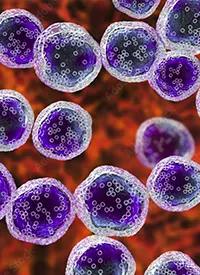Ibrutinib/Bortezomib Combo Showcases Durable Efficacy in R/R MCL and High-Risk Features
The combination of ibrutinib and bortezomib elicited durable responses in patients with relapsed or refractory mantle cell lymphoma and high-risk features such as a Ki-67 over 30%, blastoid or pleomorphic variant, p53 overexpression, and TP53 mutations and/or deletions.
Ibrutinib/Bortezomib in R/R MCL |
Image Credit: © Dr_Microbe -
stock.adobe.com

The combination of ibrutinib (Imbruvica) and bortezomib (Velcade) elicited durable responses in patients with relapsed or refractory mantle cell lymphoma (MCL) and high-risk features such as a Ki-67 over 30%, blastoid or pleomorphic variant, p53 overexpression, and TP53 mutations and/or deletions, according to data from a phase 1/2 trial (NCT02356458) published in eClinicalMedicine.1
The doublet elicited an overall response rate (ORR) of 81.8% (90% CI, 71.1%-89.8%) in evaluable patients (n = 55), meeting the trial’s primary end point. Among those who responded, 16.4% achieved a complete remission (CR), 5.5% had an unconfirmed CR (CRu), 60.0% experienced a partial remission (PR), and 9.1% had stable disease (SD); 7.3% of patients experienced progressive disease (PD). With continued ibrutinib maintenance, the ORR increased to 87.3% (90% CI, 77.4%-93.9%). Best responses included a CR for 34.5% of patients, CRu for 7.3%, PR for 45.5%, and SD for 5.5%; in this phase, 7.3% experienced PD.
The median time to best response with the doublet was 2.4 months (95% CI, 2.1-4.0). At a median follow-up of 25.4 months (95% CI, 22.4-31.9), the median duration of response (DOR) was 22.7 months (95% CI, 12.3-NA). In those who achieved CR/CRu as their best response, the median DOR was 30.8 months (95% CI, 7.43-NA) vs 22.7 months (95% CI, 7.95-NA) in those who had a PR.
The median progression-free survival (PFS) was 18.6 months (95% CI, 12.5-NA). In those who had a CR/CRu as their best response, the median PFS was 32.9 months (95% CI, 9.33-NA); in those who experienced a PR, the median PFS was 24.5 months (95% CI, 9.92-NA). The median overall survival (OS) had not yet been reached (NR; 95% CI, 36.1-NR).
“With this investigator-initiated trial, we provide clinical evidence on the value of a combination of ibrutinib and bortezomib, two well established drugs, in patients with MCL,” the study authors wrote. “Collectively, we show that this combination is an active regimen to treat patients with relapsed or refractory MCL. We propose this combination as a new and valid option especially for patients with MCL who have biological high-risk features, and as a comparator for future phase 3 trials incorporating appropriate biomarkers.
The trial enrolled patients with a centrally confirmed MCL diagnosis that was relapsed or refractory following up to 2 lines of chemotherapy. The protocol was amended in December 2016 from a maximum of 2 prior lines of treatment to any number of prior treatments.
Those who had prior exposure to ibrutinib or bortezomib, with central nervous system disease, neuropathy from previous therapy that was grade 2 or higher and in need of anticoagulation, and those with active hepatitis B or C or human immunodeficiency virus, were excluded.
Study participants received 6 cycles of ibrutinib plus bortezomib, followed by maintenance treatment with ibrutinib.
The phase 1 portion of the research utilized a 3+3 dose-escalation design and had a key objective of determining the recommended phase 2 dose of the doublet. Bortezomib was given at a fixed dose plus ibrutinib at 420 mg daily for 21 days (dose level 1) or 560 mg (dose level 2). The primary end point was evaluating dose-limiting toxicities in cycle 1. The phase 2 portion had a Simon’s two-stage min-max design with a primary end point of ORR by CT or MRI assessment.
In the efficacy-evaluable patients (n = 55), the median patient age was 71 years (range, 47-90). Most patients were male (78%) and had an ECOG performance status of 0 (75%). Moreover, 63.6% of patients previously received 1 line of therapy, 27.3% received 2 lines, 5.5% received 3 lines, and 3.6% received 5 lines. Twenty-nine percent of patients had received high-dose chemotherapy with BEAM and undergone autologous stem cell transplantation.
Additional data showed that in patients with Ki67 of higher than 30% (n = 28), the ORR with the combination was 68% vs 96% in those with a Ki-67 of less than 30% (n = 24). In those with blastoid/pleomorphic disease (n = 9), the ORR was 56% vs 87% in those without (n = 46). In those with aberrant p53 status (n = 16) vs those with normal status (n = 23), the ORRs were 81% and 87%, respectively. In patients who had any of the aforementioned characteristics (n = 34), the ORR was 74% vs 91% in those who did not (n = 11).
In the maintenance phase, in those with a Ki-67 that was higher than 30%, the ORR was 79% vs 96% in those with a Ki67 lower than 30%. Those with and without blastoid/pleomorphic disease had ORRs of 67% and 91%, respectively; those with aberrant or normal p53 status experienced ORRs of 81% and 96%, respectively. Patients who had any of the aforementioned high-risk features had an ORR of 82% vs 91% in those who did not.
The most common adverse effects experienced by the overall population (n = 55), included diarrhea (47.3%), decreased platelet count (41.8%), fatigue (40%), fever (29.1%), peripheral sensory neuropathy (25.5%), nausea (21.8%), injection site reaction (21.8%), hematoma (20%), constipation (20%), oral mucositis (18.2%), paresthesia (16.4%), vomiting (16.4%), lung infection (14.5%), conjunctivitis (14.5%), cough (14.5%), decreased neutrophil count (14.5%), hypertension (12.7%), bronchial infection (12.7%), skin infection (12.7%), edema in the limbs (12.7%), dry skin (12.7%), flu-like symptoms (12.7%), anorexia (12.7%), dizziness (10.9%), upper respiratory infection (10.9%), dyspnea (10.9%), maculopapular rash (10.9%), and back pain (10.9%).
Reference
Novak U, Fehr M, Schär S, et al. Combined therapy with ibrutinib and bortezomib followed by ibrutinib maintenance in relapsed or refractory mantle cell lymphoma and high-risk features: a phase 1/2 trial of the European MCL network (SAKK 36/13). EClinicalMedicine. Published online September 22, 2023. doi:10.1016/j.eclinm.2023.102221



